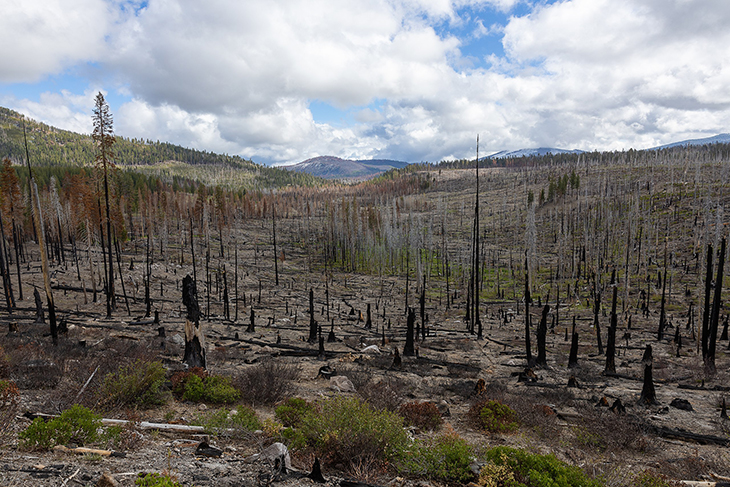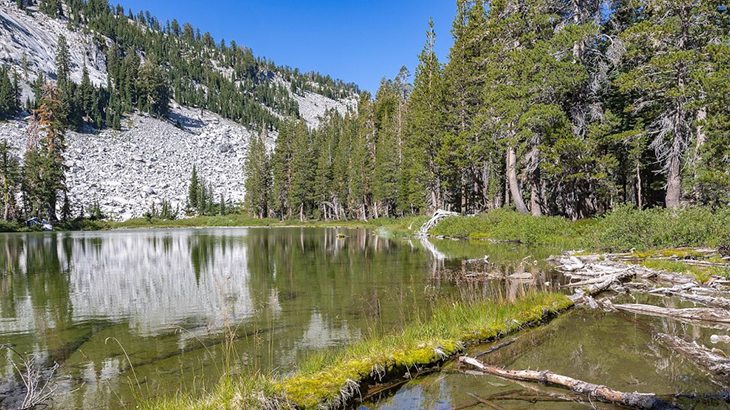
In 2021, the Dixie Fire etched its name into California’s history books as the most substantial singular conflagration the state had ever witnessed. Despite being a firestorm fueled by human activities, it failed to suppress the indomitable resilience of nature.
The destructive path of the Dixie Fire unfolded in August, mercilessly sweeping through Lassen Volcano National Park in Northern California. The aftermath resembled a scene from “Mordor,” with certain areas left desolate. However, a feature piece in The Guardian highlighted the remarkable ability of nature to swiftly reclaim what had been scorched.
As the relentless Dixie Fire approached the remote national park, which typically receives a modest 500,000 visitors annually, a coalition of rangers, Forest Service personnel, and firefighters collaborated on strategies. Their primary focus was twofold: safeguarding the small communities adjacent to the park and preserving the park’s vital infrastructure.
Drawing inspiration from traditional practices of Native Americans, controlled burns were employed. These intentional fires, utilized for centuries, aimed to reduce the risk of catastrophic wildfires by clearing excessive dead and dry vegetation. Around the Kohm Yah-mah-nee visitor center, earth-moving equipment left swathes of barren earth as a defensive measure.
In the critical moments preceding the arrival of the Dixie Fire, firefighters initiated controlled burns in strategic locations. This tactical move seemed designed to deplete the available oxygen, hampering the fire’s potential for rapid expansion. The concerted efforts of these firefighting measures yielded positive results—the historic towns of Mill Creek, Mineral, and Old Station, along with the Kohm Yah-mah-nee visitor center, emerged unscathed.
While the rest of the park bore witness to the devastation, with entire forests reduced to charred remnants, the park’s staff exhibited a stoic understanding. Lassen Volcano National Park had endured the unleashed forces of destruction once before in 1915 when the volcano erupted, leading to its designation as the nation’s 17th national park. The cyclical nature of destruction and renewal underscored the enduring spirit of resilience within the heart of this natural sanctuary.
The Land of Changes
From May 14th to 22nd, the southernmost volcanic peak in the Cascades Range experienced a sequence of eruptions, featuring over 180 steam explosions that created a 1,000-foot-wide crater on the summit. The following day, luminous lava blocks were observed cascading down the slopes of Lassen, visible from as distant as the town of Manton, situated 20 miles to the west.

As per the information provided by the United States Geological Survey (USGS), multiple steam explosions during a volcanic event propelled lava blocks onto a snow-covered slope. This, in turn, triggered an avalanche that obliterated a four-mile stretch of mountainous terrain to the northeast. Simultaneously, a mudslide, induced by meltwater from the lava, wreaked havoc across seven miles of terrain to the northwest.
On May 22nd, the culmination of these volcanic activities resulted in the most significant eruption, sending a colossal column of volcanic ash and gas soaring more than 30,000 feet into the atmosphere. This phenomenon was observable from as far away as Eureka, located 150 miles to the west.
The impact of the eruption on Lassen Peak’s northeastern slope led to the generation of a high-speed avalanche composed of hot ash, pumice, rock fragments, and gas—a pyroclastic flow. This destructive force covered an area of three square miles, causing widespread devastation. The pyroclastic flow instigated a secondary mudslide, tracing the path of the previous one and racing nearly 10 miles down Lost Creek to Old Station. This subsequent mudslide released a substantial volume of water, resulting in a second flooding of lower Hat Creek Valley.
As the volcanic activity subsided, the aftermath left behind a landscape reminiscent of Mordor, akin to the aftermath observed in Dixie.
“People say: ‘I’ve never seen it like this my entire lifetime that I lived here.’ In my lifetime, it’s all I see,” Park Ranger Russell Rhoads told The Guardian after the latest devastation. “Fire was suppressed during your entire lifetime, the fuels accumulated and now it’s just unmanageable.”
Over two years have elapsed since the Dixie Fires swept through, and signs of renewal are now evident across the landscape. Certain areas, once charred and desolate, are now bursting with new life. Pines, dependent on fire to release their seeds, are emerging from the previously scorched soil. Hillsides, once dominated by the remains of ravaged trees, are now adorned with vibrant fields of wildflowers and native grasses.
Within the seemingly lifeless stumps and logs, a hidden ecosystem thrives. Rotting wood provides a habitat for grubs, beetles, and mushrooms, forming a crucial link in the food chain for woodpeckers, bears, and various other wildlife.
Rhoads, an expert on the region’s ecology, emphasizes that the entire ecosystem of Lassen has historically emerged from the crucible of fire and devastation, having rebounded numerous times over the ages. Though it may take a decade or so more, the impact of the Dixie Fires will eventually become a fleeting chapter in the extensive history of the region—a narrative characterized by cycles of change, destruction, and rejuvenation. For the National Park Service, this wildfire served as a valuable testing ground for firefighting strategies, offering essential lessons that will shape their approach to future conflagrations.
What are your thoughts? Please comment below and share this news!
True Activist / Report a typo


